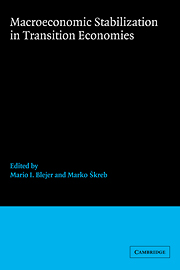Book contents
- Frontmatter
- Contents
- List of Contributors
- Preface
- Introduction Stabilization After Five Years of Reform: Issues and Experiences
- PART I GENERAL STUDIES
- 1 From Plan to Market: Patterns of Transition
- 2 The Great Contractions in Transition Economies
- 3 Enterprise Credit and Stabilization in Transition Economies: Experience with Enterprise Isolation Programs
- 4 Employeeism: Corporate Governance and Employee Share Ownership in Transitional Economies
- PART II COUNTRY STUDIES
- PART III AFTERWORD
- Index
3 - Enterprise Credit and Stabilization in Transition Economies: Experience with Enterprise Isolation Programs
Published online by Cambridge University Press: 09 October 2009
- Frontmatter
- Contents
- List of Contributors
- Preface
- Introduction Stabilization After Five Years of Reform: Issues and Experiences
- PART I GENERAL STUDIES
- 1 From Plan to Market: Patterns of Transition
- 2 The Great Contractions in Transition Economies
- 3 Enterprise Credit and Stabilization in Transition Economies: Experience with Enterprise Isolation Programs
- 4 Employeeism: Corporate Governance and Employee Share Ownership in Transitional Economies
- PART II COUNTRY STUDIES
- PART III AFTERWORD
- Index
Summary
Stabilization programs should incorporate budgetary allocations to assist downsizing large money-losing enterprises in which output has collapsed but where such enterprises remain the major provider of “public goods”: artificial employment, social services, and public utilities to workers and dependent populations. This is particularly important where no overall GDP growth is expected in the short run and when labor markets are not integrated – that is, workers probably will not leave these enterprises voluntarily as part of overall labor mobility.
Budgetary allocations to assist directly in divesting such public goods may have to come early, and take priority over commercial bank recapitalizations and even over credit expansion to the rest of the economy. Otherwise, the pressures for subsidized credit and arrears financing for these enterprises will remain, some of it being used to artificially maintain output levels. This will threaten both the sustainability and the efficiency of the stabilization program.
By combining, under one institutional roof, both (a) the isolation of enterprises from banking system credit and (b) the provision of budget resources to divest public goods, enterprise isolation programs may be an efficient tool to achieve downsizing. Credit cuts may become more acceptable if labor and interested communities are assured that resources will be available for severance payments, labor redeployment assistance, and the transfer of social services. This assurance should become an important incentive when overall fiscal revenues are scarce.
- Type
- Chapter
- Information
- Macroeconomic Stabilization in Transition Economies , pp. 100 - 125Publisher: Cambridge University PressPrint publication year: 1997

